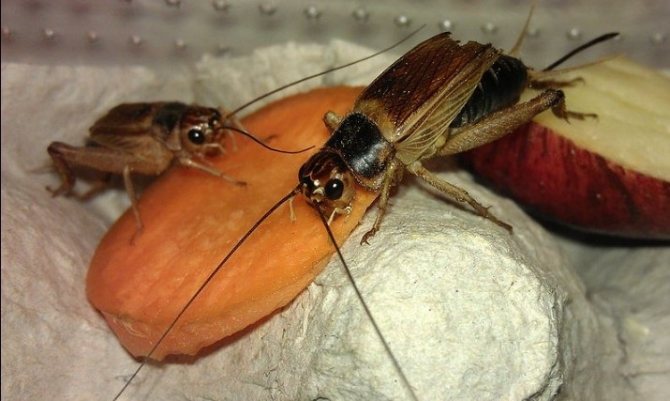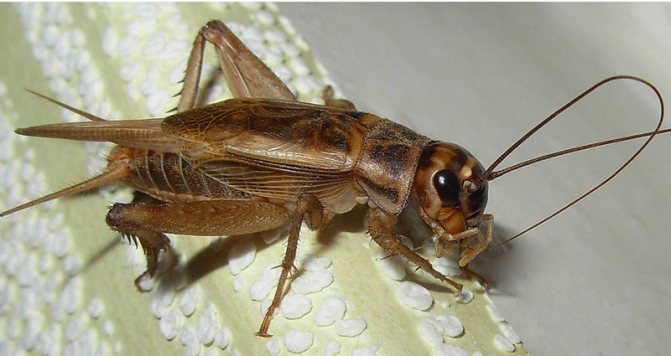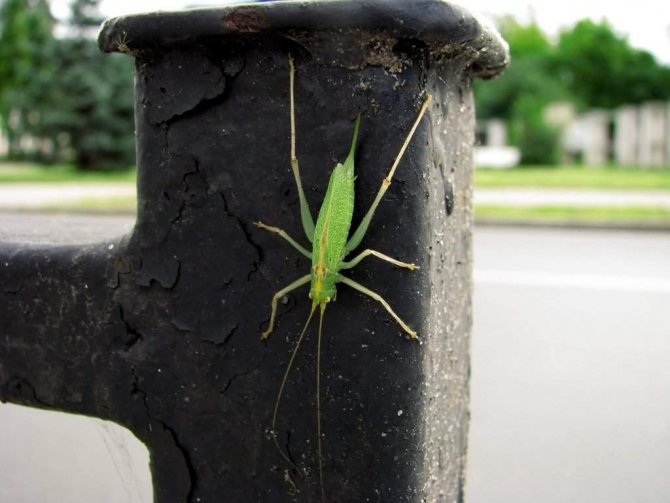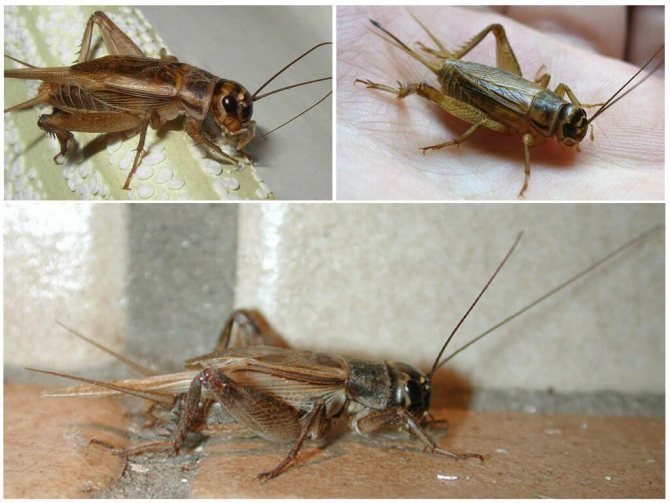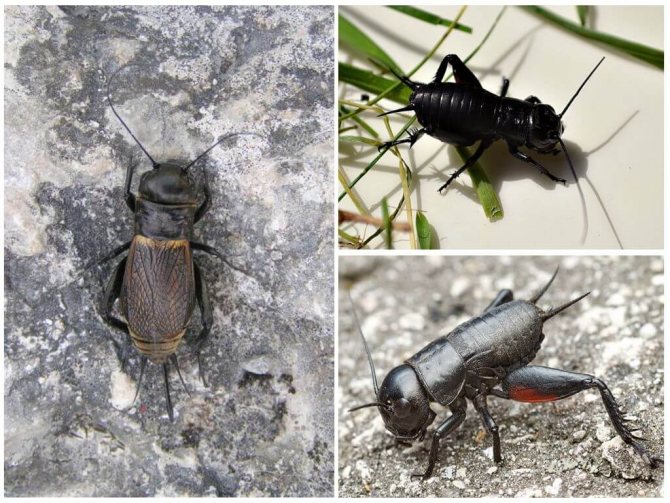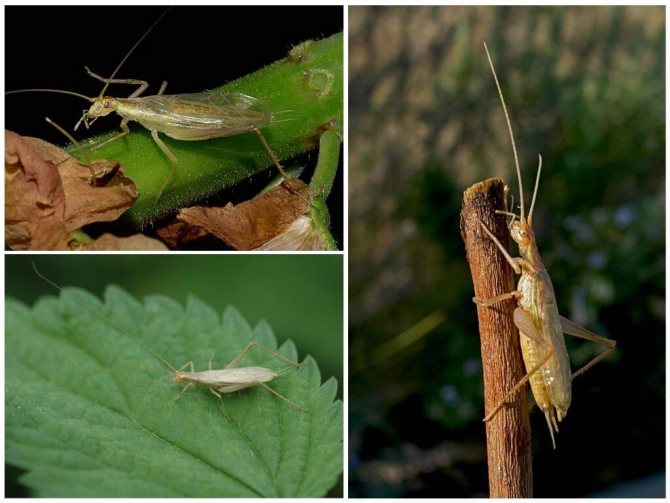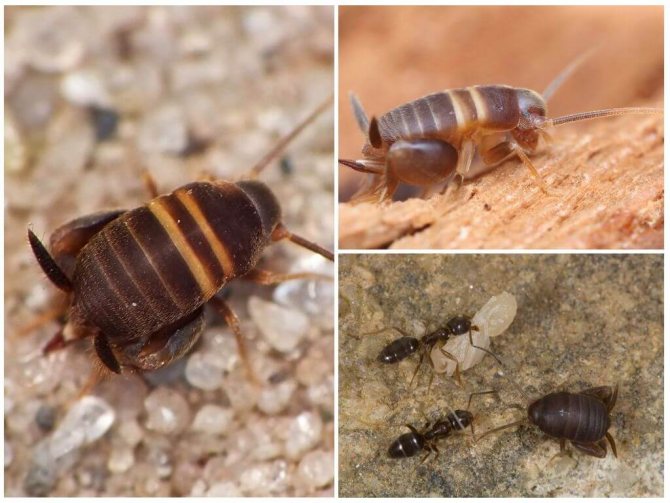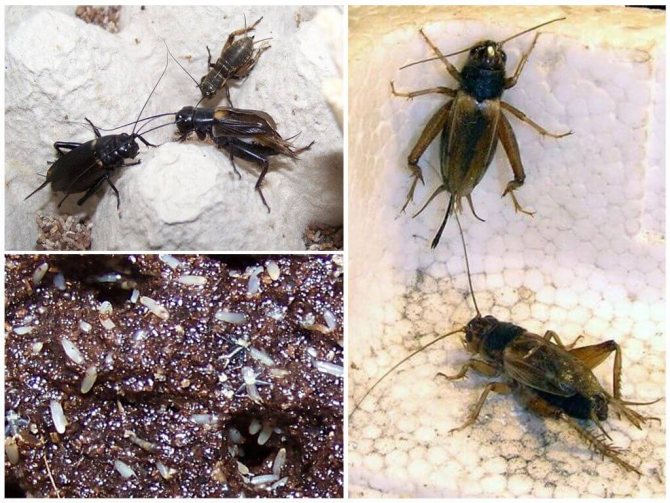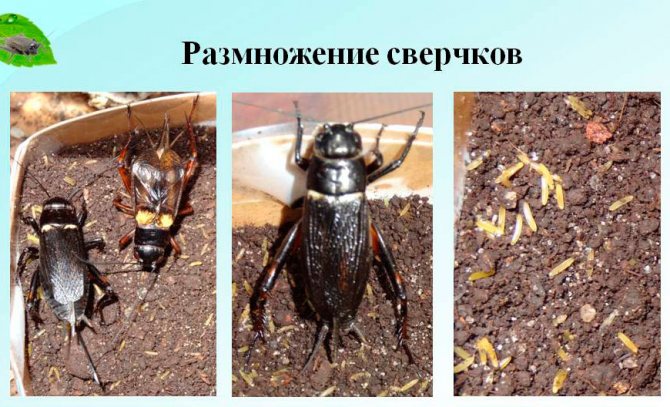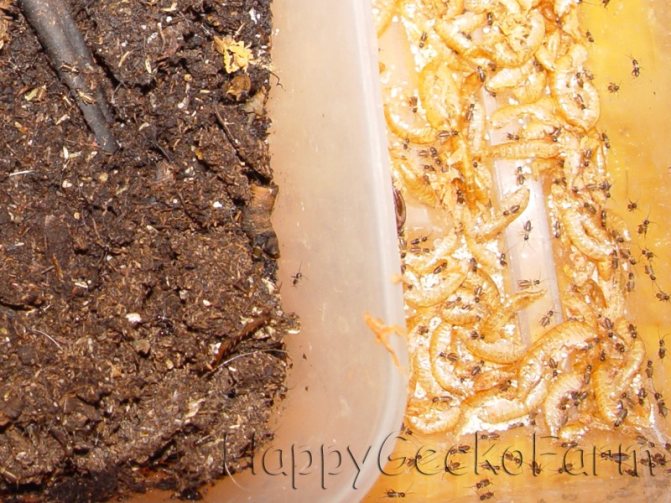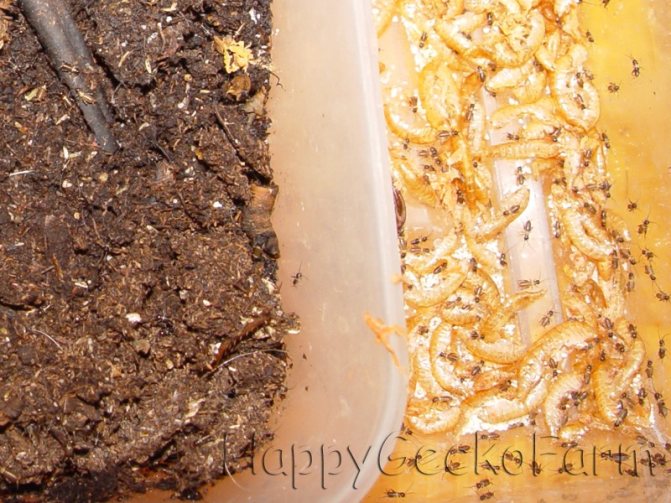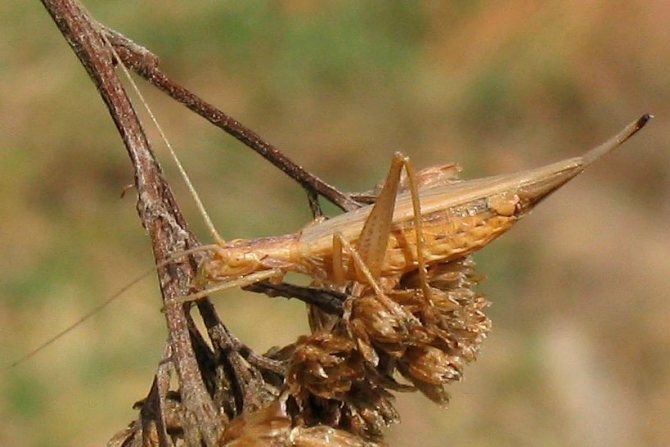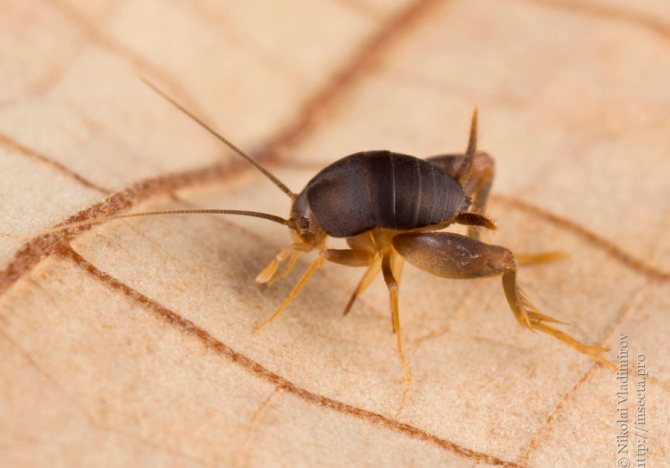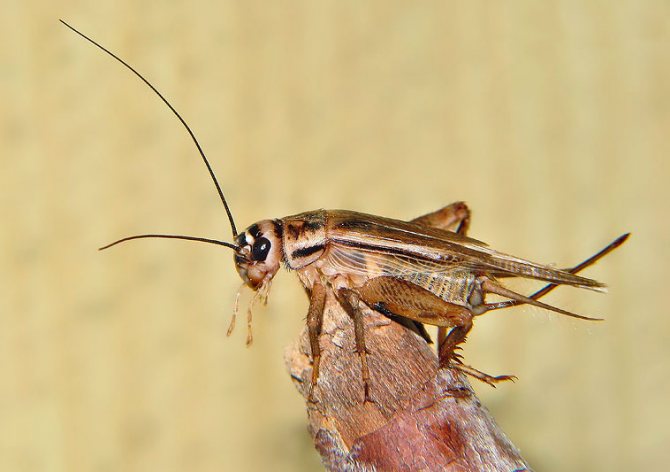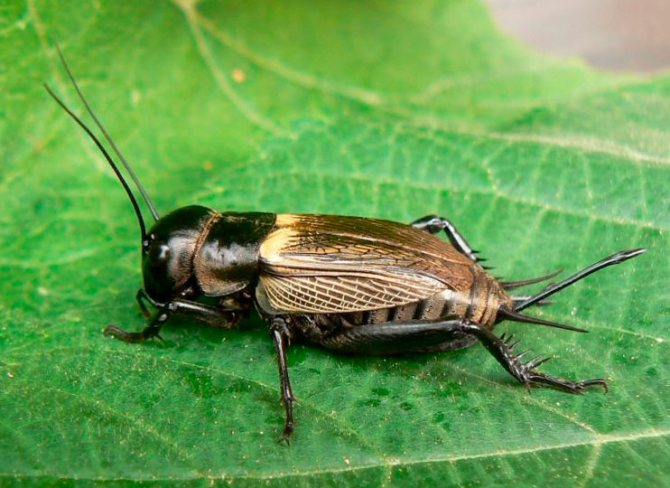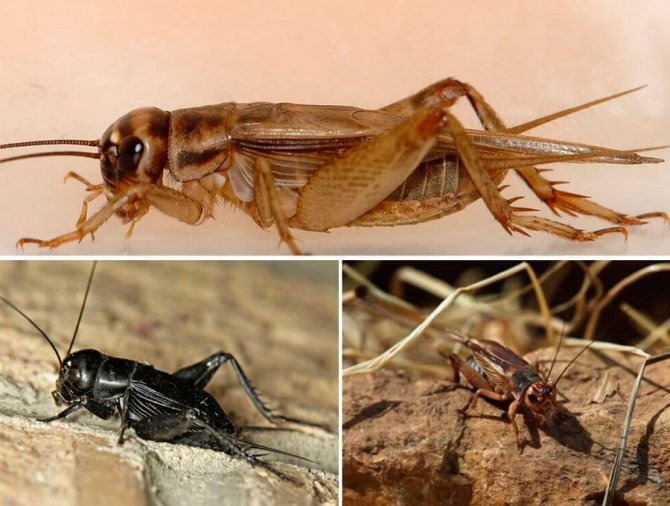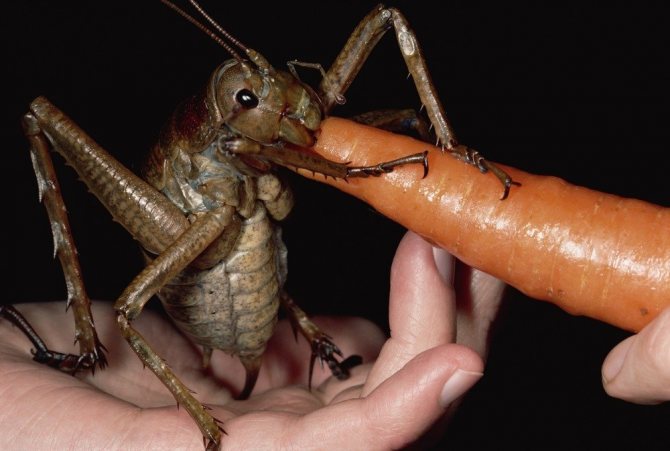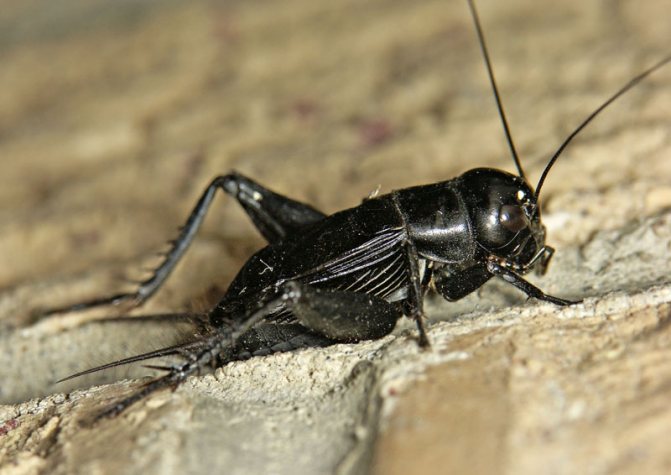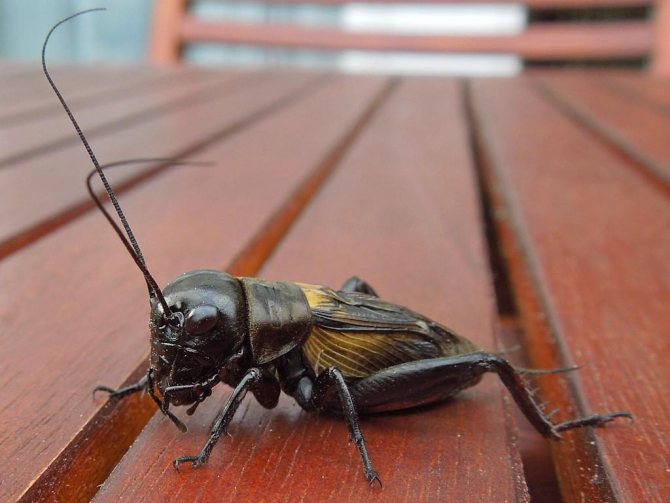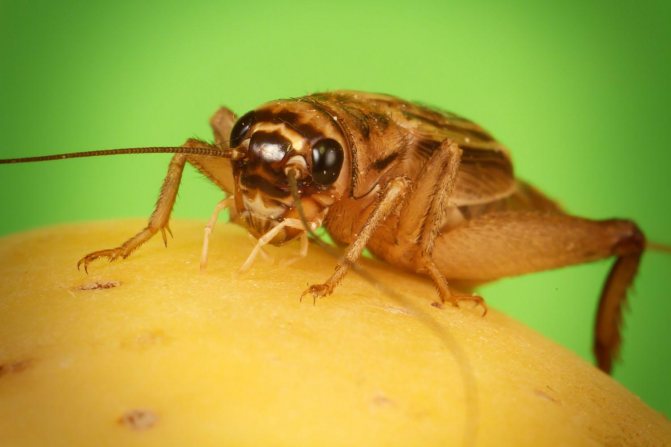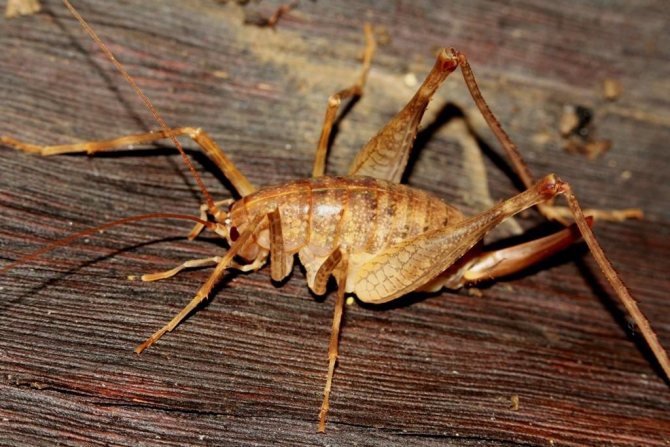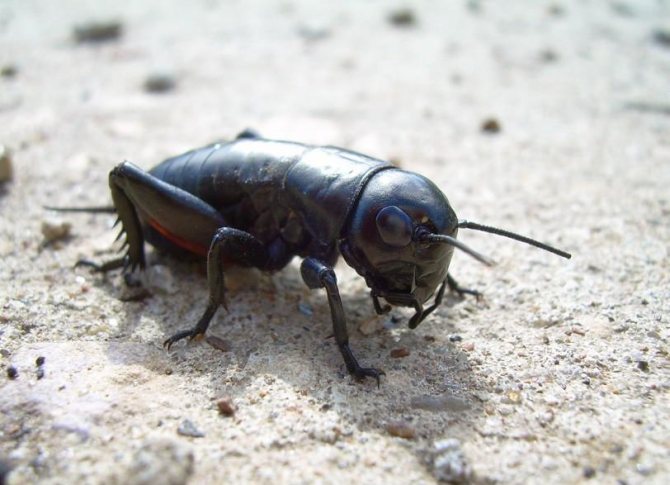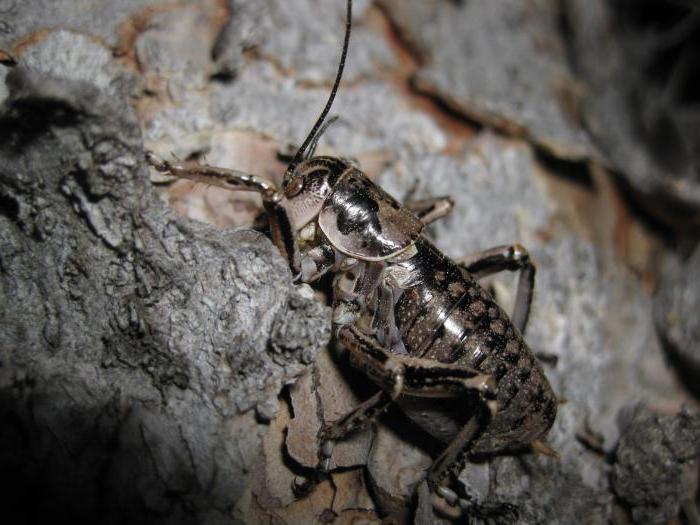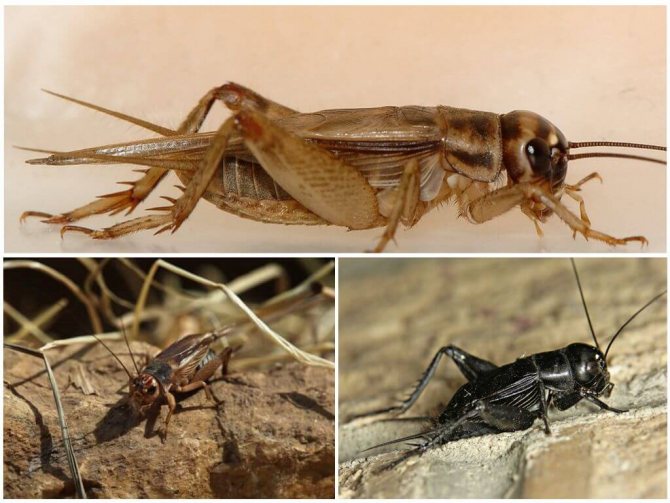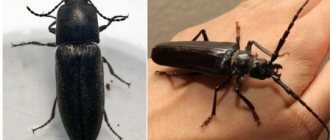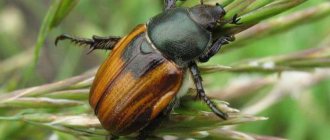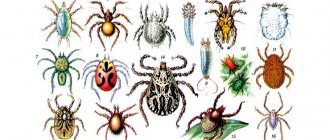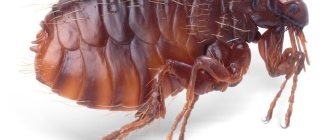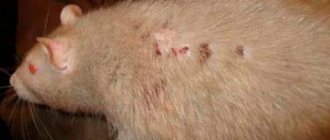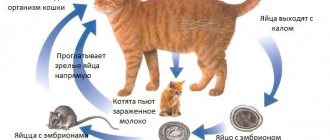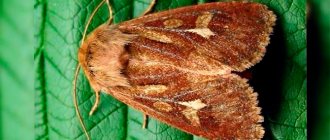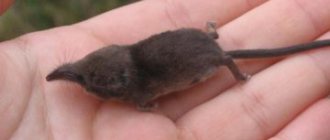Cricket - a frequent hero of fairy tales for children. it insect, perhaps, the only one that does not cause hostility when he settles at home.
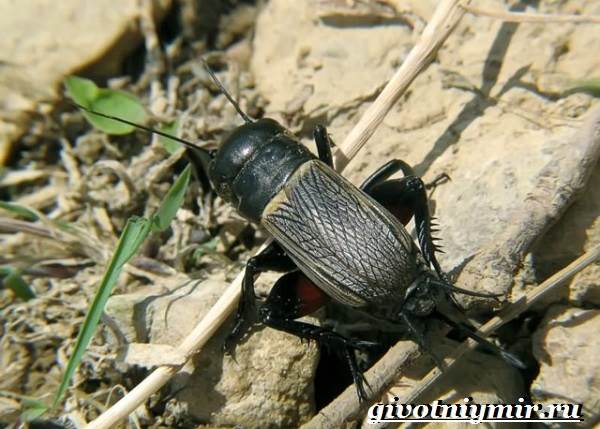
People treat him with sympathy and curiosity, his chirping is considered one of the symbols of home comfort and peace. In Japan and China, this insect is especially revered and even kept in small cages in their homes to listen to its songs. In North America, it is bait for fishing, and in Asia it is eaten. So who is this cricket? Where does these melodic sounds come from and is it beneficial or harmful?
Description
Crickets belong to the Orthoptera order, which includes grasshoppers, locust... These are small and medium-sized insects with cylindrical, vertically flattened bodies. The head is spherical with long thin antennae, behind them are two large compound eyes. There are three eyes on the forehead (simple eyes).
The first thoracic segment is trapezoidal, strong. The insect is smooth, has neither dorsal nor lateral ridges.
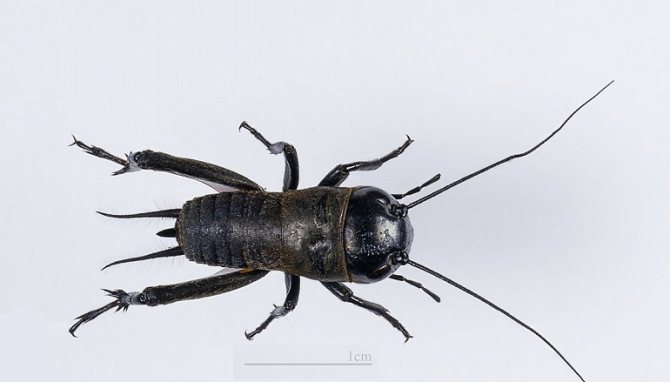

At the tip of the abdomen there is a pair of long churches (paired appendages of the posterior segment). In females, the ovipositor is cylindrical, long, narrow, smooth, and shiny. The hips of the rear pair of legs are greatly extended for jumping.
The shins are armed with several mobile spurs, the location of which is typical for each species. The shins of the forelegs are used to receive sound.
The wings lie on the body, varying in size in different species. The front wings are made of strong chitin, which acts as a protective shield for the soft parts of the body.
Males possess stridulatory organs for sound production. The rear pair is membranous, folds like a fan under the front wings. In many species, the wings are not adapted for flight.
The largest are bovine crickets 5 cm long (brachytrups), which dig holes a meter or more deep. Oecanthinae, arboreal are delicate white or pale green insects with transparent front wings, field (Gryllinae) - strong, brown, black.
Appearance
The domestic cricket resembles a massive medium-sized grasshopper with a straight back.
- In ordinary grasshoppers, the wings are folded like a house. Crickets have three pairs of paws. The latter, like grasshoppers, is long and can push a domestic cricket upward. But he doesn't use his catapult to jump. The insect needs this pair of paws only to throw its body up, where it can spread its wings for flight.
- Crickets fly very well.
- The singing mechanism, also located on the hind legs, gives the cricket an additional resemblance to a grasshopper.
- The head is large. It has a pair of large faceted eyes.
- The mouth apparatus is a gnawing type.
Long cerci located at the end of the abdomen give a frightening look to the domestic cricket. They are associated with stings. But house crickets are harmless insects. The female has a long (11-15 mm) ovipositor between the cerci. The body length of a cricket is 1.5-2.5 cm. The color of the cricket's body varies from yellowish to brown.
A photo of a house cricket, taken from above, gives an idea of what this human companion looks like.
Cricket life
Habitat
They live in all parts of the world, with the exception of cold regions, latitudes above 55 ° north and south latitude.The greatest diversity is found in tropical locations such as Malaysia, where 88 species chirp near Kuala Lumpur.
Members of several subfamilies live in the treetops, bushes, and grasses. They are found on the ground, in caves, some are underground, digging shallow or deep burrows. Others live in rotting wood, on the beach, and can run and jump on the surface of the water.
Where do they live and how to detect parasites?
Crickets live in humid and warm places, so it is worth finding such a place in the garden. It is also possible for crickets to settle somewhere in the house. In places such as bathrooms and basements. Sometimes the insect can settle in the attic. If you have not found an acceptable place to live on the street, and it still harms the plants in the garden, you should look for the parasite in the greenhouse, sheds and garages.
One of the ways to destroy an insect that has settled on the street can be hanging out feeders, because the birds eat them.
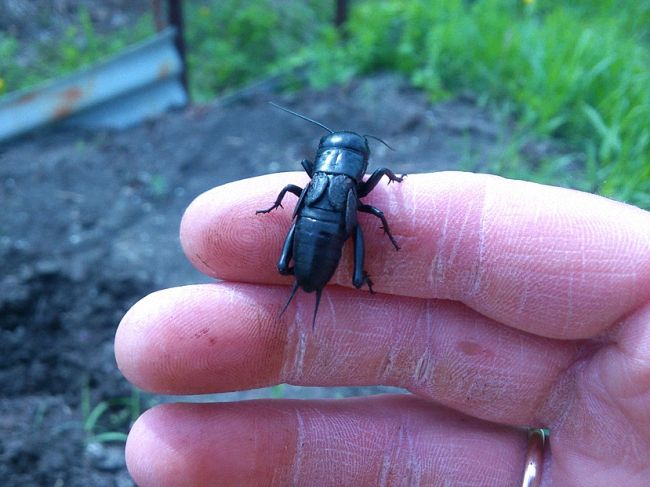

Chirping
Most crickets make a loud sound, stridulation. The stridulatory organ is located on the fore wing, which has a leathery structure.
Learn more Grasshoppers: description, behavior, nutrition
The calling song attracts females and repels other males, and is quite loud. The aggressive song is triggered by contact chemoreceptors on the antennas, which detect the presence of an opponent.
Crickets chirp at different speeds depending on the species and ambient temperature. Most chirp faster at high temperatures (62 chirps per minute at 13 ° C).
The relationship between temperature and chirping frequency is known as Dolbier's law. According to this law, counting the number of chirps produced in 14 seconds and adding 40 indicates the temperature in degrees Fahrenheit.
Ground crickets (Nemobiinae) are wingless, others have small front wings and no hind wings (Copholandrevus). Gryllus assimilis fly efficiently and well, others are clumsy pilots.
Why and where do these insects appear in an apartment or house
In nature, crickets live close to humans, preferring old buildings with many cracks, old rugs and high humidity. With a cold snap, insects move to new buildings, meeting even on the upper floors. The reason is the renovation or complete overhaul of the house.
One of the reasons for the appearance of uninvited guests in a multi-storey building is the breeding of "night singers" by one of its inhabitants and the escape of crickets from the place of detention.
Insects can be delivered both as part of the product and in things from the previous home.
In human homes, insects need warmth and food. Damp warm rooms with abundant food have become favorite places for crickets. Therefore, the lack of cleanliness, a considerable amount of food waste in uncovered trash cans are perceived by insects as invitation cards.
House crickets have chosen warm basements, warehouses, industrial premises as their habitats; they also settle warmly in people's homes. Crickets move into the premises with a cold snap.
Insects are omnivorous. In natural conditions, they prefer plant foods. But the diet is diversified by eating other insects and even young individuals of their own species.
In a human home, crickets prefer food leftovers: pieces of fruits, vegetables, bread crumbs. Crickets eat cockroaches, moths. The "singers" like droplets of drinks, excluding alcoholic ones.
During the day, uninvited guests hide under the baseboards, hiding in dark secluded corners.
Finding "neighbors" is possible only with the onset of darkness by sound.
What do crickets eat, do they bite people?
Domestic crickets are omnivorous. Deprived of their natural nutrition, they accept a wide variety of organic foods. Some are completely herbivorous, feeding on flowers, fruits, leaves.Terrestrial species consume seedlings, herbs, pieces of leaves, shoots of young plants.
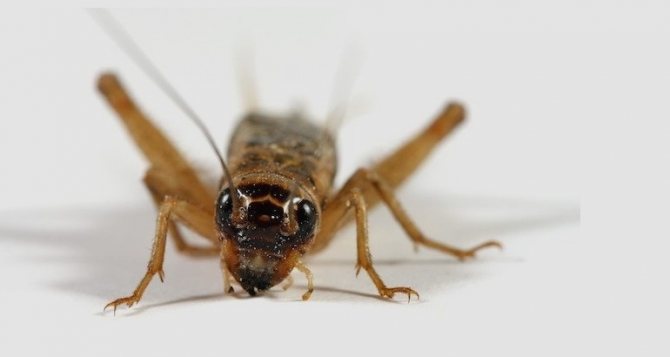

Others are carnivorous, eating eggs of invertebrates, larvae, pupae, scaly insects, aphids. Many are scavengers, consume organic residues, decaying plants, fungi. In captivity, domestic crickets are successfully reared on dry dog food with the addition of lettuce and aphids.
They have relatively strong jaws and several species bite humans.
Food
They are not picky about food. It is enough for them in the summer. All plant foods are used, from grass to plant roots. In winter, in secluded home dwellings, they also do not remain hungry.
If a hunger strike comes for them, then crickets do not hesitate to lay eggs of similar insects or dead relatives, which once again emphasizes their tendency to cannibalism.
Crickets, bred specifically as an ornamental domestic insect, eats everything they give it - fruits, vegetables, food for other animals, bread crumbs, baby food and table scraps.
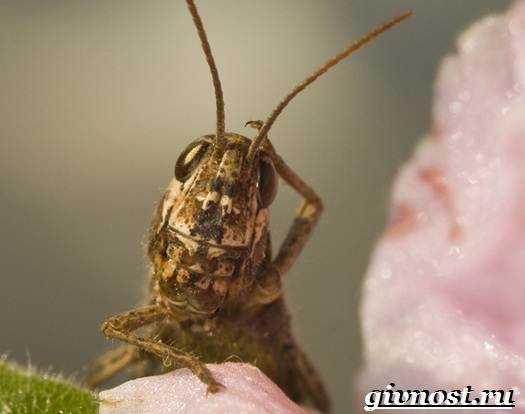

Insects need protein foods, which are found in fishmeal and egg white. Overeating by insects is categorically contraindicated. From it, their chitinous coating deteriorates and the problem with molting begins.
All vegetables and fruits are best grated. A prerequisite for crickets is the availability of water. It is not necessary to pour it into the drinking bowl, it is enough to moisten the sponge with it well.
Life cycle
Male crickets establish dominance over each other by aggression. They start by hitting each other with antennas and inflating the mandibles. If they do not retreat at this stage, they resort to a fight, each one makes sounds that are completely different from those that are heard under other circumstances. When someone wins - sings loudly, the loser is silent.
Females are attracted to males by song. After mating, the female eats the spermatophore (male reproductive organ).
Eggs are laid on the soil, in the plant stems. For this, females have a long, needle-like ovipositor. Terrestrial inhabitants do without it, either lay eggs in an underground chamber, or push them into the wall of the hole.
A short-tailed cricket (Anurogryllus) digs a hole with cameras, lays eggs in a heap on the floor, after the eggs have hatched, feeds the offspring for about a month.
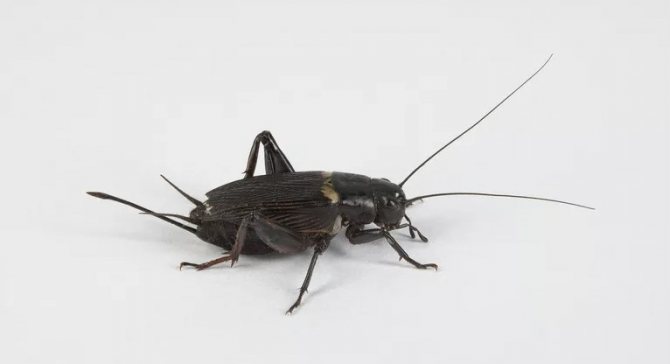

They are hemimetabolic insects - the life cycle consists of the stage of the egg, the nymph, which resembles the adult form, the adult. The egg grows into a nymph the size of a fruit fly.
The nymph goes through about 10 stages, with each successive molt it becomes more like an adult. After the last molt, the genitals and wings are fully developed, but a maturation period is required before the insect is ready to reproduce.
In the struggle for the attention of the ladies
The ladies of the male cricket hearts are picky enough and force the gentleman to persuade them during the day: waltz around the chosen one, drive off rivals, sing serenades. In case of victory, the male hangs a special bag with seed material - a spermatophore - from the abdomen of the lady of the heart and quickly retracts. This precaution is explained by the fact that the fertilized female becomes very voracious and, in a fit of hunger, can eat her lover.
Eggs are laid one week after fertilization. After half a month, tiny larvae emerge on the surface of the soil. Before the onset of the stage of an adult insect, they will have to survive 4-6 molts. The strength and size of the jaws - these are the characteristics of the larvae and adult crickets.
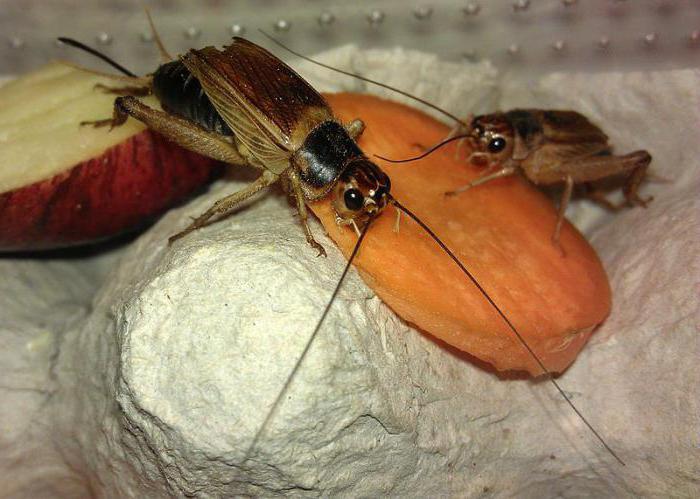

What do insect babies eat? Their diet consists of fruits, berries and tender shoots - in general, pasture.
Pets and for fighting
Crickets are kept as pets. An insect singing in a home is a sign of good luck and potential wealth. They are so treasured that they are often displayed in beautiful bamboo cages.
In China, Japan, some European countries, especially on the Iberian Peninsula, they are kept in cages or hollowed out pumpkins, specially created forms. Insect fighting is a traditional Chinese pastime that dates back to the Tang Dynasty (618–907).
Learn more about Scorpion bites: symptoms and treatment
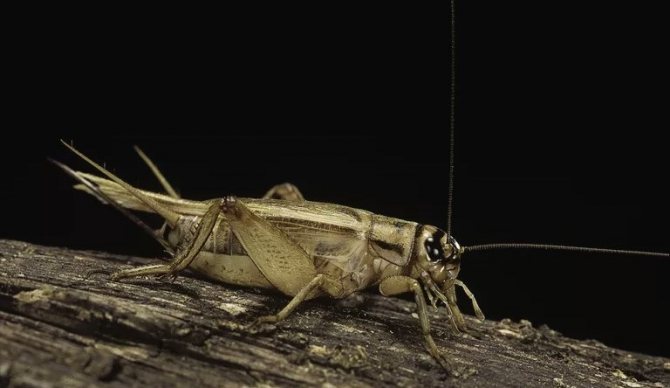

The dominance and fighting ability of males does not depend only on strength. It has been found to become more aggressive after isolation, or when defending a shelter. Crickets, forced to fly briefly, fight two to three times longer than they could.
Cricket fights "without rules"
The aggressiveness of male crickets gave rise to an unusual gambling spectacle - fighting. There is a version that they were invented in China about 1000 years ago, during the reign of Sun. But cricket fights were also held with equal success in Thailand and Malaysia.
For this, insects were caught at the end of summer. Then male crickets were released into the mini-arena. They instantly began to fight to the bitter end. The defeated one was thrown out of the arena, fled from it, or was killed by an opponent. The winner was even awarded a certain title.
These cricket fights were very expensive, and the stakes were very high. The remains of the winners were then stored in silver mini-coffins. During their lifetime, specially hired people looked after the fighting crickets. The insects were on a specially designed diet, and even medications were given to them for colds. To raise the tone and morale of the crickets, females were brought daily for 2 hours.
They kept fighting insects in special semi-precious houses or in a pumpkin or bamboo hollowed out from the inside. Sometimes the cages were ivory or turtle shell. The most beautiful houses were found only in the imperial palaces.
Are they eaten?
In southern Asia, including Cambodia, Laos, Thailand, Vietnam, insects are eaten as a snack made by deep-fried soaked and refined insects.
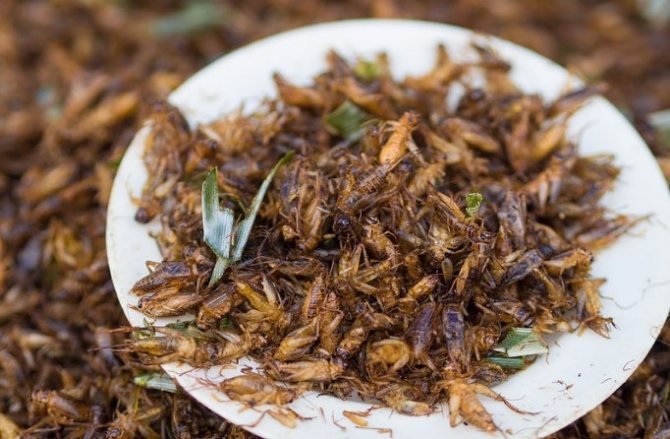

Cricket flour is used as an additive to consumer products such as pasta, bread, crackers, and biscuits. Flour is used in protein bars, pet food, livestock, industrial purposes.
They are bred as food for predatory zoo animals, laboratory animals and domestic animals.
They are high in protein and calcium. Every 100 grams of insects you eat will provide 13 grams of protein and 76 milligrams of calcium.
Growing crickets at home
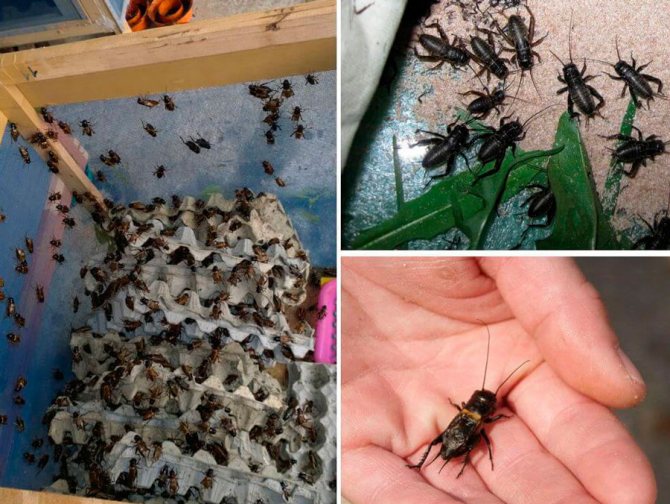

Recently, the cultivation of various insects in artificial conditions has become popular, having built primitive insectariums. Crickets are insects that take root without problems in such conditions, especially since they feel comfortable next to a person. They are often bred to feed other pets.
An insectarium is a simple structure of small dimensions made of glass or plastic, the bottom of which is filled with a mixture of peat and sand. To keep it light and warm, it is enough to install an incandescent lamp. installation of ventilation is desirable, as well as maintaining humidity at 40%. It is enough to define 3 males and no more than 15 females in one container.
The diet of adults should include the remnants of various homemade foods, as well as apples and carrots, but only in grated and not large portions.
The diet should contain plant foods, in the form of tops from vegetables and lettuce, as well as burdock leaves. Protein is necessary for their vital activity, therefore, the diet should contain components such as fishmeal, chicken eggs or gammarus.
Naturally, they just need moisture, so a moistened sponge should be in the insectarium.
As a rule, in every zoo there are insectariums, and of impressive size. This is necessary in order to feed the natural ingredients of some animals and birds.
How to get rid of crickets
For some, the sounds of crickets evoke images of sultry summer nights; for others, the continuous chirping only evokes rage. Indoor crickets interfering? If so, try strategies to get rid of them.
Chirping in the yard: a familiar sign of summer. For some people, this sound has no charm, if you are unlucky, the chirr has settled right under the bedroom window or sneaked into the house, the sound becomes a nighttime nuisance.
Unfortunately, getting rid of crickets requires more than just standing by the door and yelling, "Quiet!" Crickets do not listen to commands, no matter how desperate or sincere they may be. But there are other, more sophisticated tactics to respond to. Read on to find out how to get rid of them.
Step 1: Find the source
The first and most difficult step is figuring out where the crickets are hiding. It is best to follow the chirping sound. Keep in mind that as you approach or near the nest, they will calm down and interfere with your efforts. Regardless, hearing helps narrow down the search field.
When searching, focus on the elements that provide shelter, as crickets like to nest in dark, humid environments. Look under the layers of mulch, a pile of compost.
If you can find the nest, there are two ways. One is to stop watering this piece of property, depriving the crickets of the water they need to survive. A somewhat more radical method is to fill it with water. The goal is to get the singers to leave the nesting site.
For a lasting solution to the problem, you need to go even further. Because as soon as you resume regular watering, the crickets can return. To prevent this from happening, be sure to use expanding foam to fill the slots you find.
Step2: do it yourself or buy a pesticide
Crickets seeking shelter enter the house through cracks in the foundation, tiny holes around windows, doors. If it’s too late to prevent access by sealing the building envelope, there are several ways to get rid of the uninvited crickets.
Do not discount the classic sticky traps, glue boards. If you're looking for an easy, inexpensive way, look no further than the kitchen pantry. A jar filled with a 1:10 mixture of molasses and water works great. Crickets attracted to the jar by the sweet smell will not be able to escape and will drown.
Alternatively, choose a store-bought pesticide spray. Follow the directions carefully, be aware that indoor crickets like to sit in places where it is dark and humid. Therefore, concentrate the pesticide application in the most likely places, such as under the kitchen sink.
Learn more Symptoms of Lyme disease if a person is bitten by a tick
Step 3: preventative outdoor maintenance
Since you are dealing with an infection, it is important to take steps to prevent it from recurring. No matter how well the house is sealed, it will never be completely protected from insects, despite your best efforts.
Mowing the lawn, weeding the garden beds, cleaning up the litter in the yard - removing hiding places - all these discourage crickets. Also, try to create distance between the house and its landscape by trimming bushes near the basement. If you have a supply of firewood, try to keep the logs away from your home. And don't forget to clean out the gutters, this is an infamous pest harbor.
Finally, since light attracts crickets, consider limiting the use of outdoor lighting or switching to motion-sensing lights.
Prevention measures
To prevent crickets from appearing in the house again, you should:
- attach mosquito nets;
- handle the corners and slots near the batteries so that the larvae do not hatch;
- do not leave crumbs on the kitchen table;
- keep the room clean and dry.
For prophylaxis against crickets on the site, you need:
- use low-power lamps in the yards;
- it is advisable to place compost as far as possible from the dwelling;
- keep front gardens in order;
- do not leave garbage on the street.
All the methods described are also used in greenhouses. In open areas, it is better to use methods such as duct tape, trapping pit, plants and a sweet trap are possible, but they are unlikely to be effective. Therefore, in the open air, chemical and biological agents are usually used.
Jerusalem crickets
Seeing the Jerusalem cricket for the first time is a disturbing experience, even for those not prone to entomophobia. They look like giant, muscular ants with humanoid heads and dark beads. Although Jerusalem crickets (family Stenopelmatidae) are actually quite large, they are harmless.
How do they look
In the 19th century, people used the expression "Jerusalem!" as a swear word, and this is believed to be the source of the name.
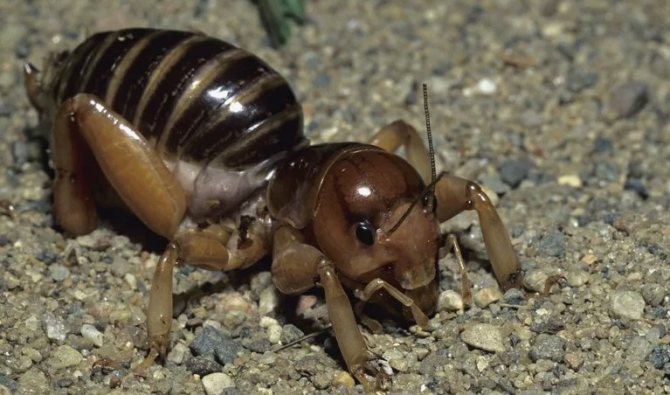

People also believed (incorrectly) that these strange insects with human faces were highly venomous and potentially deadly, which is why they were given nicknames rife with superstition and fear: beetles with bones around their necks, an old man with a bald head, a child's face, Child of the Earth (Niño de la Tierra). Among entomologists, they are called sand or stone crickets.
Jerusalem crickets are 2 - 7.5 cm long, weigh up to 13 g. Most of these flightless insects are brown in color, have a striped belly with alternating stripes of black and light brown.
They are rather large, with strong abdomens, large round heads. They do have strong jaws and can inflict a painful bite if handled incorrectly. Some species jump to avoid danger.
What do they eat
Jerusalem crickets feed on organic matter in the soil, both living and dead. Some collect garbage, hunt other arthropods.
They practice cannibalism on occasion, especially when they are together in captivity. Females often eat partners after the relationship ends (similar to praying mantis cannibalism, which is better known).
Special behavior
Insects flap their spiny hind legs in the air to ward off perceived threats. They are an important food source for bats, skunks, foxes, and coyotes.
If the predator manages to pull the leg out, the Jerusalem nymph can regenerate the missing limb.
Reproduction
Reproduction of crickets occurs when insects create comfortable conditions and an abundance of food. There must be at least 4 females in the population for 1 male, otherwise deadly fights and deafening rattling are guaranteed. A small container (4 cm deep) is placed in the container, into which wet peat, sand or plain earth is placed. Females will lay their eggs here soon. To avoid ruining the clutch by males, this container should be covered with a fine mesh or strainer. Soon the larvae will appear, which after a few molts will become adults.
Breeding crickets at home is a fairly simple task. The main thing is to create suitable conditions - temperature, humidity and refreshment, and then give the pets the required amount of food: dry and wet. Females are quite undemanding to conditions, so very soon the population will begin to rapidly increase.
Breeding crickets is big business
Thanks to the demand created by reptile owners and breeders who eat crickets, breeding is a multimillion dollar business. Large breeders raise up to 50 million insects at a time in warehouses. The common house cricket, Acheta domesticus, is raised for the trade as a pet.
A source
Jerusalem Crickets (Orthoptera, Stenopelmatidae), by David B. Weissman, Amy G. Vandergast, and Norihimo Ueshima. From Encyclopedia of Entomology, edited by John L. Capinera. “Crickets and Temperature,” University of Nebraska-Lincoln Department of Entomology. Cranshaw, Whitney and Redak, Richard. “Bugs Rule! An Introduction to the World of Insects. " Elliott, Lang and Hershberger, Wil. "The Songs of Insects."


